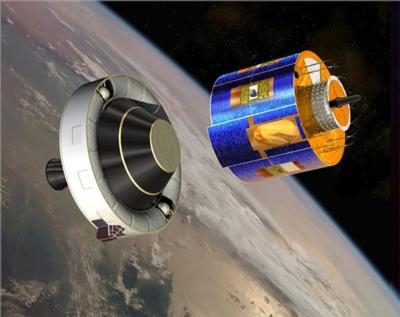Spacecraft Scheduled For Launch July 15
Ground control teams are ready to shepherd Europe’s next weather satellite through its critical first days in orbit, ensuring it is working and healthy in the harsh environment of space.

On July 15 a team of experts will be sitting ‘on console’ in the Main Control Room at ESA’s European Space Operations Centre, ESOC, in Darmstadt, Germany, watching intently as the latest Meteosat Second Generation satellite, MSG-4, separates from its Ariane launcher. As with its three predecessors, information from the last of the MSG series is required for the ‘nowcasting’ of high-impact weather and for continuing climate research.
MSG satellites, dubbed Meteosat once operating, provide full-disc images over Europe and Africa every 15 minutes and ‘rapid scan’ imagery over Europe every five minutes.
They are operated by Eumetsat – the European Organisation for the Exploitation of Meteorological Satellites – and ESA is responsible for their design, development and in-orbit delivery.
Ariane flight VA224 is set for liftoff in a 37-minute window starting at 21:42 GMT (23:42 CEST) on Wednesday, July 15. MSG-4 will separate from Ariane’s upper stage about 40 minutes after launch, a few minutes after its co-passenger, Embratel’s Star One C4 satellite.
Separation marks the start of ‘LEOP’ – the launch and early orbit phase – when the satellite comes under control of the teams at ESOC, who will take it through a series of health checks and turn on up some of the units including the instruments.
This is one of the most critical phases of any satellite’s life, and experts spanning a range of specialities, including mission operations, flight dynamics, software and ground stations, will work 24 hours per day to ensure MSG-4 is operating as it should.
“In many ways, it’s a text-book LEOP for us, and very similar to the services we provided for the first three MSG satellites,” says ESA flight director Nigel Head. “Nonetheless, we are training as thoroughly for this as for any mission, and we will be especially engaged for the most critical steps, including the orbital manoeuvres and the ejection of the main camera covers.”
During the 12-day LEOP, the satellite will fire its apogee motor four times to take it to its final geostationary orbit high above Europe, where it will be kept as a ‘hot backup’ for Eumetsat’s current Meteosat fleet. “Even during the ride to space, MSG-4 will be switched on and sending us a continuous feed of live information on its status so we can keep a constant check on how it’s doing,” says Spacecraft Operations Manager Steve Foley. “However, it is only when we are able to establish a commanding link, as soon as possible after separation from the Ariane launcher, that we can get going with our well-rehearsed operations.”
The first commands are expected to be sent about 41 minutes into flight, using the tracking station at Malindi, Kenya.
The mission control team have conducted numerous simulation training sessions using the ground systems and tracking stations that will enable engineers to control the satellite in space. Experts from ESA’s ESTEC technical centre in the Netherlands, Eumetsat and the satellite manufacturer, Thales Alenia Space, also trained to be ready for any possible contingency.
After separation, flight dynamics specialists will use radio signals and other data received from MSG-4 to assess the accuracy of the satellite’s orbit injection, determine its trajectory and orientation, and then compute the duration of the motor burns to reach its final destination over the course of the next 12 days.
(Image provided by ESA)
 Airbus Racer Helicopter Demonstrator First Flight Part of Clean Sky 2 Initiative
Airbus Racer Helicopter Demonstrator First Flight Part of Clean Sky 2 Initiative Diamond's Electric DA40 Finds Fans at Dübendorf
Diamond's Electric DA40 Finds Fans at Dübendorf ANN's Daily Aero-Term (04.23.24): Line Up And Wait (LUAW)
ANN's Daily Aero-Term (04.23.24): Line Up And Wait (LUAW) NTSB Final Report: Extra Flugzeugbau GMBH EA300/L
NTSB Final Report: Extra Flugzeugbau GMBH EA300/L Classic Aero-TV: 'Never Give Up' - Advice From Two of FedEx's Female Captains
Classic Aero-TV: 'Never Give Up' - Advice From Two of FedEx's Female Captains



